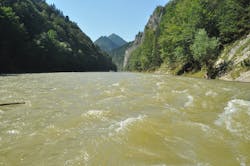Schneider Explores New Resource for Microgrids — River Currents
A selling point for microgrids is that they can use just about any form of generation, making them able to reap the benefits of local resources.
Mostly, however, they use solar, batteries and fossil fuel generators.
But Schneider Electric has begun incorporating an unusual resource into microgrids built in remote areas — river currents. The industry giant is collaborating with ORPC, a small Portland, Maine, company that provides the RivGen Power System.
Schneider became attracted to river generation because it provides an alternative to diesel fuel for remote communities that cannot easily — or cost effectively — connect to a central grid.
A baseload renewable
In an interview with Microgrid Knowledge, Bala Vinayagam, senior vice president for Schneider’s microgrid business, described an additional benefit offered by ORPC’s river generators — their power is baseload. This guarantees electricity when the sun isn’t shining on a microgrid’s solar panels or a battery is depleted. In fact, the solar and batteries within the microgrid act as backup power to the river generation.
A river with enough depth and flow offers a steady current and therefore consistent power. The system won’t work well in a stagnant or seasonal river. So ORPC tends to focus on areas of the world with adequate rivers, such as the US, Canada, Chile, the Philippines and southeast Asia, according to Vinayagam.
Igiugig, Alaska, will serve as the site of the first microgrid created by Schneider and ORPC using the river generation technology.
Located where Lake Iliamna feeds the Kvichak River, the tiny hamlet of 68 people cannot be reached by road. Residents rely on air and water to supply deliveries and travel over paths to reach other nearby villages. Most villagers fish, hunt and gather food for subsistence.
ORPC installed its system in the village in 2014 and updated it in 2015. Since then, the river generator — attached to a mooring system below the surface of the river — has proven it can handle the harsh, remote climate. The unit continued to provide power even when the temperature in the village fell as low as 40°C below zero during three winters.
This is because the river doesn't freeze at the depth the system is placed. “The temperature remains more or less stable,” Vinayagam said.
The Igiugig river generator system extends roughly 15 feet down into the water and spans about 52x47 feet wide and 11 feet high.
Reducing diesel use, lowering costs
To create a true microgrid for the village, Schneider is integrating battery energy storage and its cloud-based software controller system with the river generator. After the microgrid begins operating this summer, the village will be able to forgo the use of diesel fuel 60%-90% of the time, according to Schneider.
Remote communities are sometimes described as “last-line” areas because any transmission lines extended to the communities would be the last out from the grid. Building last lines is expensive. The river generation system offers cost savings because it spares the need to run the lines and decreases use of fossil fuels, while improving sustainability, according to Vinayagam.
“Developing economies can build out their electricity networks economically without using expensive, centralized grids reliant on fossil fuels,” said Alexandre Paris, senior vice president and chief operation officer at ORPC.
Some marine energy technologies, particularly offshore wind and hydroelectricity, have come under criticism for their potential to harm wildlife. But Vinayagam said that hundreds of hours of monitoring showed no harm to marine or aquatic life from the RivGen Power System.
Future of river generation?
Vinayagam sees big things ahead for river generation. For example, because the system is modular – built with 40-kW units – it can be scaled up and offers potential for use in nonremote areas as well, he said.
“It paves the way to establish marine energy as a commercially viable solution in the renewable energy mix,” Vinayagam said. “The path to net zero includes many forms of decarbonization and having microgrid systems with ORPC’s technology only widens the impact on what our solutions can provide.”
See this video for more details about river generation.
Interested in learning about more microgrids? Join us May 16-17 in Anaheim, California for Microgrid Knowledge 2023: Lights On!
About the Author
Elisa Wood
Editor-in-Chief
Elisa Wood is the editor and founder of EnergyChangemakers.com. She is co-founder and former editor of Microgrid Knowledge.
